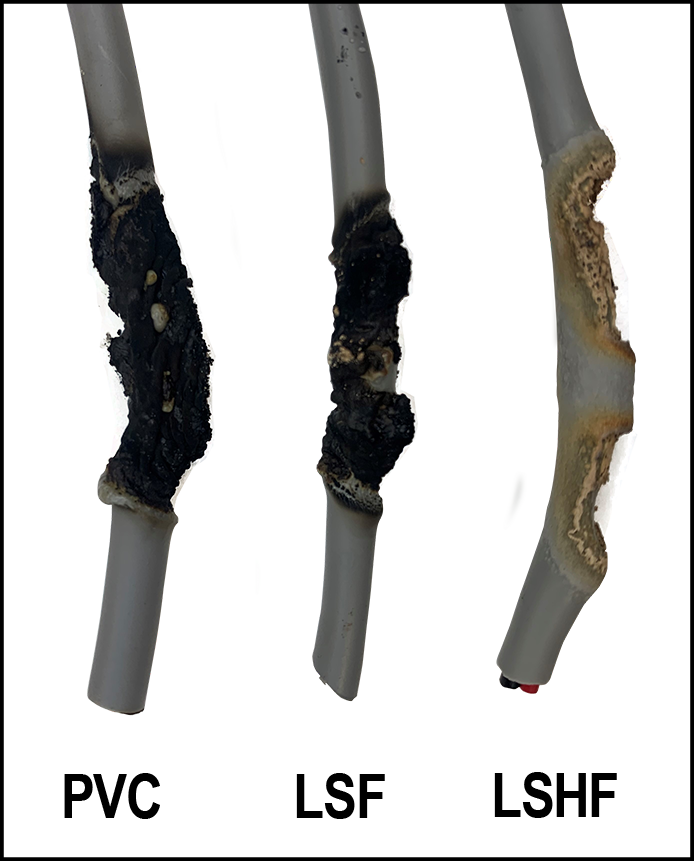Posted 20 October 2021
Burn Test at 2:10.

LSF vs LSHF - There is a Difference!
If you learn nothing more from this article, at least remember
this, LSF cable (Low Smoke and Fume) and LSHF cable (Low smoke Halogen Free)
are not different names for the same thing. But you may be forgiven if you
thought they were.
The main problem facing specifiers and contractors is the confusion over terminology and lack of standardisation. These terms are all widely used within the cable industry and we still encounter confusion from contractors surrounding the difference between LSF and LSHF cables.
Let’s get to grips with some of the commonly used head scratching
acronyms and pseudonyms.
PVC – Polyvinyl Chloride
LSF – Low Smoke & Fume
LSHF - Low Smoke Halogen Free
LS0H - Low Smoke Zero (0) Halogen
LSZH - Low Smoke Zero (0) Halogen
0HLS – Zero (0) Halogen Low Smoke
ZHLS – Zero (0) Halogen Low Smoke
LSNH – Low Smoke No Halogen
LSF – Low Smoke & Fume
LSHF - Low Smoke Halogen Free
LS0H - Low Smoke Zero (0) Halogen
LSZH - Low Smoke Zero (0) Halogen
0HLS – Zero (0) Halogen Low Smoke
ZHLS – Zero (0) Halogen Low Smoke
LSNH – Low Smoke No Halogen
To highlight the key differences here’s a brief summary of the 3
types of cables along with some of the Pros & Cons.
PVC Cables
On burning, a standard PVC (Polyvinyl Chloride) insulated cable
produces dense black smoke and a cocktail of harmful chemicals which can cause
reduced visibility and suffocation. It emits approximately 28% of Hydrogen
Chloride (HCL) gas which has a pungent smell and converts to hydrochloric acid
if it comes in to contact with water. The smoke and fumes produced during a
fire can be more dangerous to people than the fire itself.
Some points to remember about these cables are:
- They are ideal for low risk buildings, not generally for public or large commercial buildings.
- Correctly specified PVC offers greater flexibility and cost advantages over LSHF.
LSF (Low Smoke & Fume) Cables
LSF cables are usually made up of a modified PVC compound which
produces somewhat less HCL gas and smoke on burning than PVC. However, it still
produces 15% to 22 % (depending on quality) of HCL gas and due to the presence
of PVC can still emit dense black smoke. It does contain halogen, so it
shouldn’t be confused with Low Smoke Halogen Free (LSHF) cables. The amount of
PVC present in these cables can differ from manufacturer to manufacturer which
makes installing LSF cables in public places somewhat of a lottery.
Some points to remember about these cables are:
- These cables are often purchased to cut cost or through confusion with LSHF cables. They should be considered to be a small improvement over PVC cables.
- These cables are not recommended for public, large commercial buildings, near sensitive electronic equipment and where escape is limited in case of fire.
LSHF (Low Smoke Halogen Free) Cables (LS0H - LSZH - 0HLS – LSNH)
LSHF cables are made up of halogen free compounds that are good fire retardants but emit less than 0.5% hydrogen chloride gas and smoke when burnt. In case of fire these cables produce small amounts of light grey smoke and HCL gas which greatly increases the chances of escape from populated areas. There’s no PVC in these cables, hence no harmful fumes or dense black smoke are given off in case of fire.
- They are ideal for public buildings like airports and railway stations, computer rooms, datacentres, where escape is limited and fire safety is critical.
- They emit <0.5 % of HCL gas thus providing a safer environment in the event of a fire.
- The low smoke generation ensures evacuation routes and signage remain visible during a fire.
PVC vs LSF vs LSZH Conclusion
LSF cables are flexible and low cost alternative to PVC cables but
can still produce a dangerous amount of toxic gas and smoke. Whereas LSHF cables
are less flexible and a higher cost but with a significant reduction in toxic
gas and smoke. So in a high risk populated area where escape is limited LSHF cables
are strongly recommended. But in low risk areas where the evacuation is easy
and high flexibility is required, PVC could still be a good choice.
Though all of the above perform very differently with regards to
the amount of toxic fumes and smoke they produce however they all could, and in
many cases do, pass the CPR test to class Eca.
So where does
CPR come in I hear you ask!
Most cables designed for permanent installation within domestic,
residential and commercial buildings are now subject to the Construction
Products Regulation (CPR), covered by BS EN 50575 which became a legal
requirement in July 2017. The standard is primarily about the spread of fire
and heat release, not the toxicity of gases or smoke given off.
The Euroclasses
The regulation classifies products into one of seven classes, but
in most instances, only five classes will apply to cables. Lower classes Fca
and Eca undertake a basic vertical flame test to BS EN 60332-1-2. If there is a
high level of flammability, it would be classified to Class Fca (testing to Fca
can be conducted “in-house”). However, for the cable to meet the requirements
of Class Eca, the test has to be conducted by an authorised test house, known
as a Notified Body (NB) or Approval Body (AB).
In the test, a single cable of approx. 60 cm is mounted vertically
using two clamps, a flame is applied to the bottom end for 60 seconds (or 120
seconds in the case of cable diameters greater than 25 mm). The test is deemed
passed if, after the flame has been removed, the burning cable extinguishes
itself and the fire damage is less than 425mm. It is irrelevant how long the
cable burns before extinguishing itself.
Great! I hear you say! “All
I have to do is ensure that the cable I install is at least CPR class Eca
compliant and I don’t have to worry about what material it’s made from!”
If only it were that simple!
The 18th edition of BS 7671 recognises that where applicable,
cables need to meet CPR requirements and carry a Euroclass for fire
performance. BS 7671 does not specify or recommend which Euroclass to use in an
environment or application, and notably, nor does it outlaw using cables that
emit toxic fumes and smoke in the event of fire. Specifiers and installers must
therefore ensure the cables they select are appropriate for the fire risks in
the building or application and any contractual terms.
Part B of The Building Regulations does offer additional guidance.
“The primary danger associated with fire in its early stages is
not flame but the smoke and noxious gases produced by the fire. They cause most
of the casualties and may also obscure the way to escape routes and exits.
Measures designed to provide safe means of escape must therefore provide
appropriate arrangements to limit the rapid spread of smoke and fumes.”
“Okay, so I
simply specify the highest CPR class I can find, just to be safe!”
Unfortunately specifying to what many might consider to be a
‘safe’ level might prove cost prohibitive for the contractor, who may also
discover cables to higher classifications scarce or impossible to come by. Test
procedures to gain even Cca compliance are costly for manufacturers and can
involve lengthy R&D to meet the standard – there are many cable types where
it’s simply not cost effective to test to that level.
Another complicating factor is that cables redesigned to pass
higher CPR classes may shift in electrical or data performance and physical
properties - factors that may effective how they perform or their method of
installation.
Lower CPR classes focus on spread of fire, not toxic fume and
smoke emissions. Specifiers considering the emissions of cables when burnt need
to choose Low Smoke Halogen Free (LSHF) but beware, as we’ve already learned, there
are plenty of ways terminology and acronyms can trip you up.





